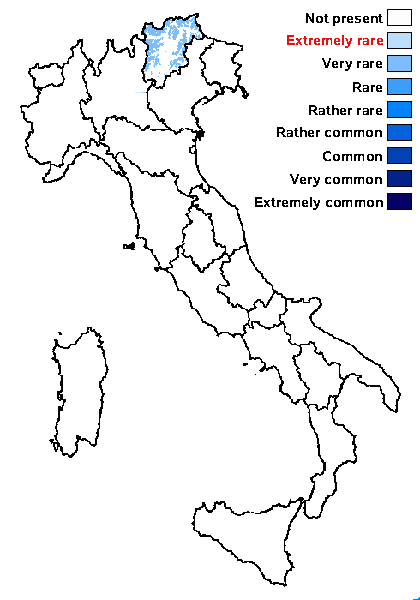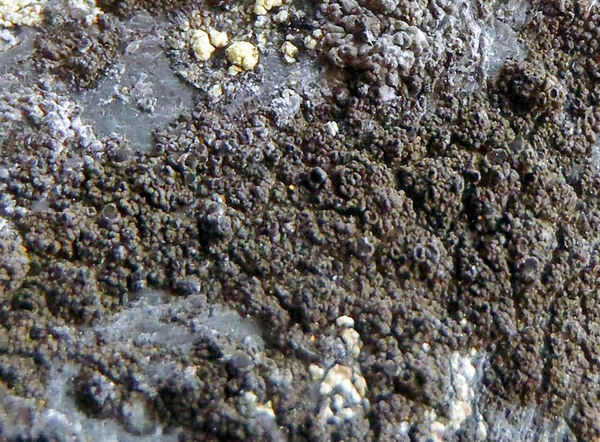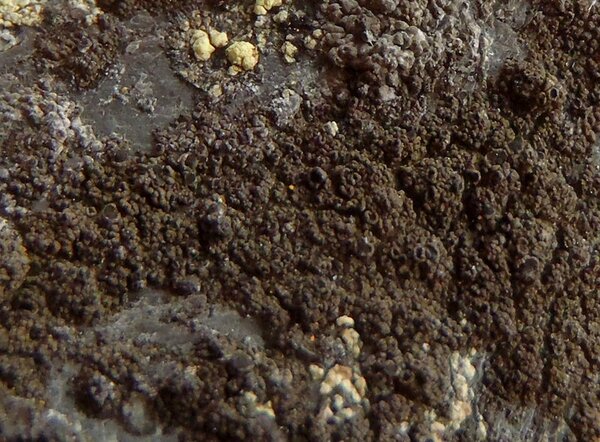Rinodina notabilis (Lynge) Sheard
The Lichen Genus Rinodina in North America: 142, 2010. Basionym: Buellia notabilis Lynge - Skr. om Svalbard og Ishavet, 81: 121, 1940.
Synonyms: Buellia parvula (H. Mayrhofer & Poelt) H. Mayrhofer & Scheid.; Rinodina parvula H. Mayrhofer & Poelt
Distribution: N - TAA (Nadyeina & al. 2010).
Description: Thallus crustose, episubstratic, forming small patches, greyish-white, ash-grey to grey-brown, not well delimited, up to 1 mm thick, the areoles usually scattered, up to 1 mm broad, angular, sublobate, sometimes developing on a thin, black hypothallus. Apothecia immersed and cryptolecanorine to sessile and lecanorine, contiguous and becoming angular, up to 1 mm across, with a concave to flat, black, scabrid disc, and a thin, crenulate, finally sometimes excluded thalline margin. Proper exciple brownish to brownish-violet in outer part, colourless within; epithecium dark brown, K-; hymenium colourless, 90-110 μm high; paraphyses branched in upper part, 1.5-2 μm thick at mid-level, the apical cells 4-6 μm wide; hypothecium colourless, up to 150 μm high. Asci 8-spored, clavate, the K/I+ blue tholus penetrated by a faintly amyloid apical cushion with parallel or diverging flanks, the wall K/I-, surrounded by a K/I+ blue outer layer, Lecanora-type. Ascospores 1-septate, slightly constricted at septum, brown, ellipsoid, 13-19 x 7-11.5 μm, Buellia-type, with a verruculose wall. Photobiont chlorococcoid. Spot tests: K-, C-, KC-, P-, UV-. Chemistry: without lichen substances. Note: on more or less calciferous rocks in upland areas; the species is known also from Austria, Switzerland, France, Slovakia, and Spain, and from North America (Sheard 2010).
Growth form: Crustose
Substrata: rocks
Photobiont: green algae other than Trentepohlia
Reproductive strategy: mainly sexual
Commonnes-rarity: (info)
Alpine belt: very rare
Subalpine belt: very rare
Oromediterranean belt: absent
Montane belt: absent
Submediterranean belt: absent
Padanian area: absent
Humid submediterranean belt: absent
Humid mediterranean belt: absent
Dry mediterranean belt: absent

Predictive model
Growth form: Crustose
Substrata: rocks
Photobiont: green algae other than Trentepohlia
Reproductive strategy: mainly sexual
Commonnes-rarity: (info)
Alpine belt: very rare
Subalpine belt: very rare
Oromediterranean belt: absent
Montane belt: absent
Submediterranean belt: absent
Padanian area: absent
Humid submediterranean belt: absent
Humid mediterranean belt: absent
Dry mediterranean belt: absent

Predictive model
 Index Fungorum
Index Fungorum
 GBIF
GBIF




